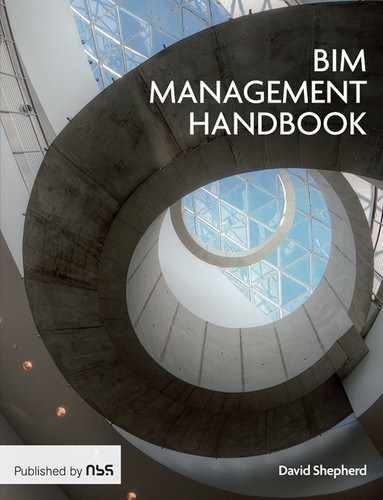02
Building Blocks for BIM Data Management: Standards, Requirements and Plans

Introduction
In this chapter, we review the best practice guidance of the BIM Task Group (an advisory group established by the UK Government and comprising representatives of major UK construction industry institutions), which has developed nationally recognised standards, forms and processes for preparing production and asset information from BIM.
The Group’s recommended approach involves a ‘Push-Pull’ mechanism. This means that, as part of the pre-qualification process, the client issues its predefined requirements for the delivery from BIM of coordinated data that will inform its decision to proceed through each project stage (Push). In turn, the supplier (i.e. the lead designer or main contractor) is responsible for coordinating the aggregation of information extracted from the combined models of the entire supply chain in order to meet those requirements in a timely fashion (Pull).
We will explore the significance and format of the Employer’s Information Requirements (EIRs). The response to these EIRs is the provision of a BIM method statement, known as the Pre-Contract BIM Execution Plan.
Once the contract is awarded, the resources and plans for information delivery are confirmed through the supplier’s provision of the Post-Contract BIM Execution Plan.
The key coverage of this chapter is as follows;
- The context of the Government Construction Strategy: BIM Level 2 and PAS-1192
- Employer’s Information Requirements
- The Pre-Contract BIM Execution Plan
- The Post-Contract BIM Execution Plan
- Information Delivery Plans.
The Context of the Government Construction Strategy: BIM Level 2 and PAS-1192
The UK Government announced its Construction Strategy in May 2011. While some of its cost reduction approaches were devoted to improved payment and procurement methods, the most innovative proposal was for all centrally procured projects to adopt fully collaborative 3D BIM – also known as BIM level 2 – by 2016.
BIM Level 2
Level 2 Maturity is defined in the Department for Business, Innovation and Skill’s BIM Working Party strategy paper as:
‘A managed 3D environment held in separate discipline “BIM” tools with data attached. Commercial data will be managed by enterprise resource planning software and integrated by proprietary interfaces or bespoke middleware. This level of BIM may utilise 4D construction sequencing and/or 5D cost information.’1
We shall clarify the meaning of 4D, 5D and other dimensions of BIM in Chapter 5. However, at this stage, the BIM Level 2 mandate establishes the importance of delivering information from the model(s) in accordance with predefined requirements.
PAS-1192
The PAS-1192 documentation is a suite of specifications introduced as a consequence of the Government’s BIM Strategy. Together, they provide guidance for collaborative project/asset information management through BIM. PAS-1192-2 describes the generic BIM workflows that should be adapted to the distinctive design, construction and asset management requirements of specific building projects.
That strategy was informed by the commissioned BIM Working Party strategy paper issued earlier that year, which established the importance of two overarching strategic actions: Client ‘Push’ and (in response to this) Project Team ‘Pull.’2
Employers’ information requirements
Client Push and Supplier Pull
In terms of ‘Push’, the same paper emphasised:
‘The Government client should be very specific and consistent about what it specifies. This includes the need to specify a set of information (data) to be provided by the supply chain to the client at specific times through the delivery and operational life of the asset.’3
It is with this in mind that PAS-1192-24 identifies the Employer’s Information Requirements (EIRs) as the means by which clients specify the information that the lead designer and main contractor are expected to provide via BIM. For all public works, EIRs are used to explain what kind of data is needed from BIM and when it should be provided. In effect, the pre-contract EIRs constitute a consistently structured Request for Proposals relating to BIM.

Figure 2.1
The Push-Pull Strategy for BIM
When preparing their EIRs, the extent of the client’s reliance on the advice of independent technical advisers will typically depend on the level of internal BIM expertise. Where the client finds that little or no such expertise is available internally, they should, at the earliest opportunity, consult an external adviser with a verifiable track record of successful BIM implementations and client satisfaction.
In addition, while the design team leader or main contractor may be well positioned to provide support in compiling the EIRs, an undesirable level of self-policing may result from appointing either of these figures to develop the self-same EIRs that will be applied to their proposed design and construction processes. The appointment of a party entirely separate from the project team to the role of BIM Technical Adviser on these matters would ensure greater accountability.
The EIRs can be broadly divided into the following Technical, Management and Commercial Requirements:5
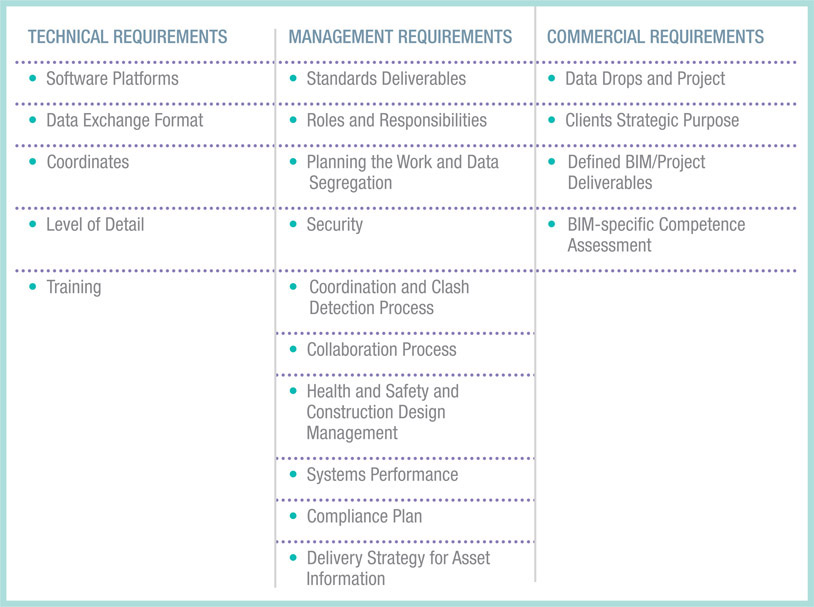

Figure 2.2 The stages of the RIBA Plan of Work 2013
The RIBA Plan of work and Plain Language Questions
The RIBA Plan of Work6 consistently organises the building design and construction process into a series of work stages.
At each juncture between these stages, it is important for clients to decide on whether the project is sufficiently viable for it to continue. The EIRs specify the format and quality of data that must be delivered from BIM in order to answer the client’s important questions about project progress. These predefined queries, designed to solicit formal responses from the delivery team, are phrased in everyday English and therefore termed the Plain Language Questions.
In summary, the EIRs establish a consistent digital format for providing data that can be reviewed by the client in order to assess and approve the project’s progress and viability at each work stage. The common term for the formal project review and approval process is the Gateway.
The UK Government’s BIM Task Group has provided examples of typical Plain Language Questions that would be posed at each work stage, along with the expected format of responses via BIM (see http://www.thenbs.com/BIMTaskGroupLabs/questions.html). The samples below relate to the RIBA Plan of Work, Stage 1: Preparation and Brief (corresponding to American Institute of Architects Phase 1).
Reviewing the Business impact of EIRs
| PLAIN LANGUAGE QUESTION | RESPONSE VIA BIM |
| How are the stakeholders’ needs captured? | An electronic brief that is in a format that may be used for automated validation of proposals. |
| What is the initial view of capital cost? | 3D model of the development’s volumes. Schedule of internal volumes, land, floor, wall and roof areas or service runs aligned with generic cost data as aggregated by the cost estimator. Fabric not normally represented. Budget breakdown. |
There are significant responsibilities involved in meeting the expectations contained in EIRs for information delivery via BIM. For each requirement, the BIM Manager should assess the contractual scope and the risks incurred by the specified information requirements, and devise a careful plan to mitigate them. In terms of the EIRs that accompany bid documentation, it is invaluable to conduct a comprehensive risk assessment that draws upon the experience and insight of the BIM Manager. A checklist like the one above is a useful tool when assessing this risk.
EIR Risk Assessment Checklist:
- What are the overall strategic purposes of BIM specified in the EIRs for this project?
- Which specific uses of BIM have been prioritised for this project?
- What is the contractual significance of the model vis-à-vis the issued drawings?
- How is the intellectual property embedded in each firm’s model contractually protected?
- At each project stage, how does the required level of detail and information relate to each firm’s contractual scope?
- Prior to commencement, what sort of digital data (e.g. site survey, electronic Schedule of Accommodations) will be provided? What are their file formats?
- What can be discovered about the proven capabilities of other firms in the supply chain to collaborate, coordinate and deliver information from BIM in accordance with the EIRs?
- How will any lack of BIM proficiency be remediated before or during the project?
- What are the existing software, processes and tools that will be employed in accordance with the EIRs?
- Which EIRs would demand a significant change over from existing tools, deliverables and work methods?
- Which requirements are unnecessarily onerous and, on that basis, should be open to amendment?
In respect of question 11, an important step would be for the assigned Project Manager and the person assuming the BIM management role to invite the client’s BIM Technical Adviser to explain the purpose of any particularly challenging requirements, with a view to achieving an acceptable compromise.
Understanding the risks incurred by these requirements, finding the compromises that will mitigate them, and persuading the client to approve such amendments are all key aspects of pre-contract BIM management. They are at least as important as the technical requirements that you will specify, should you recruit a person to perform this role.
The Pre-Contract BIM Execution Plan
PAS-1192-2 describes the Pre-Contract BIM Execution Plan (BEP) as a coherent proposal that establishes the prospective design and construction supply chain’s strategy and

Figure 2.3 The Five Components of the Pre-Contract BIM Project Execution Plan
capability to deliver the information as required by the Employer from BIM.
Self-Test Questions that will Help you to Complete the PAS-1192-related Assessment Forms:
- Describe the significance of BIM to your normative design/construction collaboration processes. What high-level business improvements (e.g. cost, time and quality) have you been seeking to derive from BIM?
- What objective criteria are you using to measure those improvements?
- Where and how have you objectively defined your firm’s CAD/BIM Standards?
- How stringently does your firm check its project documentation against those aCAD/BIM Standards?
- Identify three of your firm’s most successful project implementations of BIM. Describe the range of design and construction functions in which BIM was used. How did BIM improve project outcomes, in terms of cost, time and quality?
- What’s your experience of administering or using a Common Data Environment for the multi-disciplinary team to share?
The diagram on the facing page shows the five key components comprising the plan.
In the subsequent section, each component of the BIM Project Execution Plan will be explained in terms of what it means and what it should contain:
BEP – 1 – The Standard Method and Procedure
The Standard Method and Procedure should encompass proposals for:
- Roles and responsibilities, in particular the overall responsibility for BIM coordination and information delivery from the full range of design and construction disciplines.
- A secure online repository of shared project models and data known as the Common Data Environment (defined in PAS-1192-2 as ‘a single source of information for any given project, used to collect, manage and disseminate all relevant approved project documents for multi-disciplinary teams in a managed process).’
- Compatible software applications for model development and file formats required for information exchange.
- Common conventions for file and folder naming that would make it easy to distinguish the originator, discipline, zone, level, purpose and revision status assigned to each model.
- The means by which the Common Data Environment will logically segregate work-in-progress models from shared data and client-approved construction documentation.
It’s important to note that the primary purpose of BIM Level 2 is coordinated information management and not just the management of coordinated drawing production.
BEP – 2 – Supplier Building information Management, it and Resource Assessment
In response to the BIM-related aspects of any bid documentation, the BIM Manager will also be expected to complete a number of PAS-1192-related assessment forms on behalf of his/her firm. The responses on these forms should provide evidence-based confirmation of:
- Understanding of BIM and its applicability to the normative design/construction collaboration processes of the firm
- The design and construction functions for which BIM has been utilised and the successful project outcomes attributed to it
- IT, training/assessment and management provisions in place for project delivery in BIM
- Current processes for vetting work against CAD/BIM standards
- The extent to which the firm’s CAD/BIM Standards are aligned with national BIM standards
- Successful implementations of BIM on key projects.
These are probing questions, but answering them candidly will go a long way towards ascertaining your company’s BIM Level 2 readiness.
BEP – 3 – Project Goals for Collaboration and Information Modelling
Project goals represent the outcomes by which we measure the success of using BIM.
Let’s return to the Government Construction Strategy and remind ourselves of the key benefits that it cites for adopting BIM:
- Comparative ease in evaluating the implications of alternative design proposals
- Elimination of coordination errors and subsequent expensive change because projects are modelled in three dimension.
- Elimination of unnecessary intermediaries by linking design to manufacture by direct control of machine tools
- Establishing a proper basis for asset management subsequent to construction.
In a fully collaborative 3D environment, BIM Level 2 involves the extraction of the commercial data that has been cross-referenced to 3D elements located in the various model contributions of each discipline. In short, once the appropriate kind of data is attached to the model elements, the client should be able to use proprietary tools to extract further information from them; this information can then be analysed in order to assess and even improve project outcomes.
In line with these kinds of benefits, project goals should be described in accordance with the EIRs. Here are a few examples:
- ‘In conjunction with other consultants, BIM will be used to facilitate the client’s evaluation of design alternatives by providing 3D visualisations of different proposals with associated cost estimates, area schedules and energy usage projections.’
- ‘BIM will be used to significantly reduce the cost of design re-work by using collaborative model walkthroughs, whereby all design issues raised by consultants will be mapped to specific elements and named views of the model. Potential conflicts will be resolved by using the combined 3D model to coordinate a solution that is agreeable to all relevant parties.’
- ‘BIM will be used to make the construction process faster and safer by developing and reviewing construction sequence animations and Design for Manufacture and Assembly proposals developed from the 3D models.’
- ‘At handover, BIM will be used to provide a comprehensive verified set of asset information in a format compatible with the client’s FM system.’
Of course, these goals may incur significant immediate additional costs that will be offset by consequent savings and benefits realised later on in the project lifecycle. These need to be negotiated against the contractual scope of project participants.
BEP – 4 – Major Project Milestones Consistent with the Project Programme
The table below shows the types of deliverables that would be derived from BIM for client review at the end of each project stage.
BEP – 5 – Project Information Model (PIM) Deliverable Strategy
As a deliverable, the Project Information Model integrates actionable project data and documentation with progressively more detailed elements in the 3D model.
In its document entitled Outline Scope of Services for the Role of information Management7, the Construction Industry Council (CIC) refers to this PIM deliverables strategy as the Project Information Plan, calling it ‘the plan for the structure and management and exchange of information from the Project Team in the Information Model and the related processes and procedures.’

It adds that the plan should contain:
- a) Responsibility for provision of information at each Stage
- b) Level of detail/information required for specific Project Outputs e.g. Planning, Procurement, FM Procurement
- c) Information structure across roles e.g. software platforms (all levels of supply chain) and data structures (also known as the data schema) appropriate to the employer requirements and project team resources
- d) The process for incorporating as-constructed, testing, validation and commissioning information.
Note that once the contract is signed, for c) and d), the BIM Manager will need to complete Appendix 2 of the CIC BIM Protocol in agreement with the EIRs. This is in order to summarise the proposed Standard Method and Procedure. In particular, the summary should outline the following:
- Applicable BIM Standard
- Common Data Environment
- Spatial Co-ordination protocol
- Model approval/information exchange protocol
- Archiving procedures
- Security requirements and access rights procedures
- Resolution of conflicts
- Process for incorporating hand-over asset information, such as commissioning data.
Appendix 1 of the CIC’s BIM Protocol provides a tabular means of outlining items a) and b): For an explanation of the Level of detail/information for each project stage, please see Chapter 9.
PAS-1192 Model Federation
For BIM Level 2, each project member is responsible for organising their models and associated data in separate files that reflect the scope of their responsibilities within the overall project. At regular intervals, there is a need to coordinate these in a software environment that allows their data to be combined and used as if they were a single model. It is important to note that each discipline’s model can still function independently of others and will retain specific types of data that are not shared.
Model federation simply provides a common basis for combining, interrogating and interacting with exported models that contain information shared in accordance with agreed project collaboration requirements.
Table 2.4 reflects how model development responsibilities should be distributed among the various team members as work progresses. Further information on fig 9.1.
The extent of federation is important in relation to intellectual property. For instance, an engineer would not want to share a complex proprietary algorithm that is embedded in the structural model and that could leverage the data from any architect’s model in order to calculate the stresses, strains and bending moments. Also, consider a library of healthcare equipment that has been customised for 1:50 room layouts and room data sheets and that contains parameters capable of producing a procurement-ready Equipment Responsibility Matrix directly from the model. Clearly, in both these cases, it would make no sense to hand over data from any model that could be used by others to replicate value-adding business processes or hard-won efficiencies. Federation as described in the CIC BIM Protocol is an arrangement for sharing only as much of the model as is needed for the purposes permitted in the agreement. In the above engineering example, it means that the algorithm (and any parameters associated with it) can be stripped out of the model before issuing it to others via the project-wide data repository known as the Common Data Environment.
In the healthcare example, the architectural design model would be divided into a series of linked sub-models. While other sub-models could be shared in the format in which they were authored, the equipment sub-model might only be issued as either dumb geometry or in a format that does not facilitate the extraction of detailed product data.
The BIM Toolkit®: Defining the Deliverables
The BIM Toolkit® is a portal that verifies BIM data against defined standards for modelling and embedded information. This on-line tool provides a ready means of facilitating the Information Manager’s responsibilities and is a considerable advancement on tabular methods.
It provides a free-to-use set of tools to assist with the definition, management and responsibility for information development and delivery across the project lifecycle. It also confirms a classification system (Uniclass 2015) together with Level of Detail (LoD) and Level of Information (LoI) standards aligned to the RIBA/CIC/PAS1192 work stages, all supported by verification tools to confirm model compliance against predetermined project deliverables.
The functionality offered within the Toolkit delivers an effective project management tool, allowing project roles and tasks to be assigned to create a prescribed set of BIM deliverables for each project participant against each work stage. This is supported by LoD and LoI definitions provided on the website, giving greater clarity to project teams on required outputs as modelling progresses.
In practical terms, the entire team needs to decide on how best to divide the development of BIM into several models across the project (also known as the Volume Strategy) see fig. 2.4 below and then agree on a schedule for sharing updates to each model via the Common Data Environment.
What is the Project Information Model?
In PAS-1192-2, the Project Information Model is a logically organised data structure that is defined as consisting of:
- Documentation (i.e. information preserved as records of the briefing, design, construction, operation, maintenance or decommissioning of a construction project, including but not limited to correspondence, drawings, schedules, specifications, calculations, spreadsheets)
- Graphical information (i.e. data conveyed using shapes and 3D solids)
- Non-graphical information (i.e. data conveyed using text and numbers).
Figure 2.4
Example of a major school project divided into several sub-models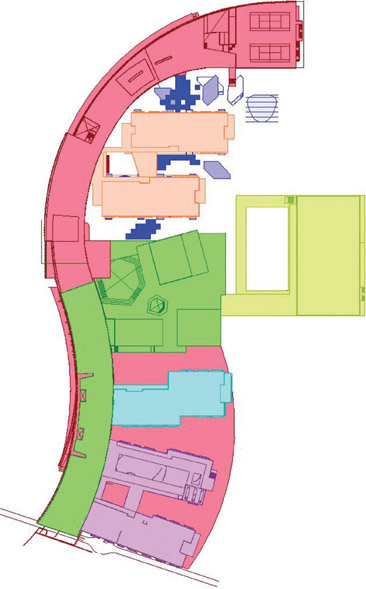
It further explains that the project information model (PIM) ‘is developed firstly as a design intent model, showing the architectural and engineering intentions of the design suppliers. Then the PIM is developed into a virtual construction model containing all the objects to be manufactured, installed or constructed. It becomes the basis of the Asset Information Model once handed over.’
In practice, the virtual construction model should be developed by the construction supply chain as a full replacement of the design intent model. In response to this requirement, the task of BIM management is to outline the plan for not only organising the variety of actionable data from all project participants into a logical structure, but also for matching and linking that information to 3D elements which will increase in detail as the project progresses.
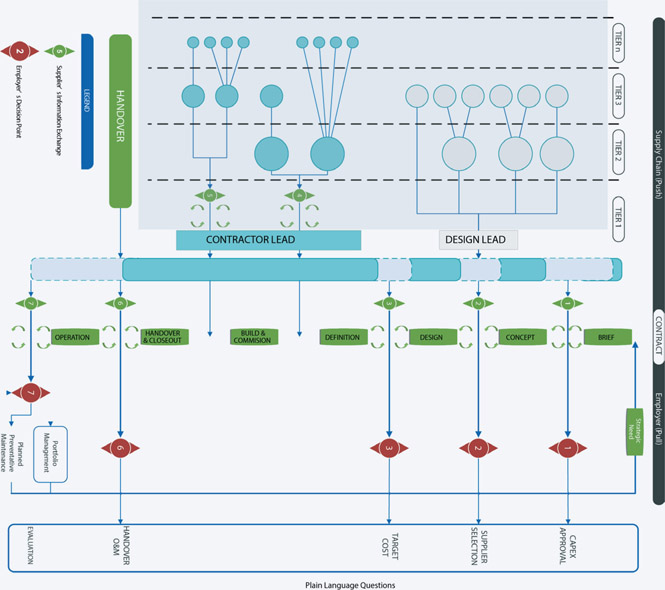
Figure 2.5
PAS-1192-2 – The whole supply chain contributes information to answer the Plain Language Questions4
One image taken from PAS-1192-2 indicates the potential complexity of this task:
In the highlighted area, note how the design lead and contractor lead are expected to organise their respective sub-consultants and specialists in order to provide models to a level of detail and integrated with information upon which decisions can be made at each project stage. The management of BIM must provide and implement processes for facilitating the development and integration of project data with models from all project participants, including those at lower supply-chain tiers who are not currently au fait with BIM. This is probably the most challenging part of the BIM management role, and will be explained in further detail in Chapter 8.
The Federated Model
Both PAS-1192-2 and CIC BIM Protocol refer repeatedly to the federated model, whereby each model contribution can be developed separately and then integrated by superimposing models in a 3D software environment after exporting to the agreed file format for design review (see Chapter 10).
Interoperability of Models
It is important to note that there is nothing in these documents that mandates integrating models in the application that was used to create them. For BIM level 2, each participant can create models in proprietary software. Nevertheless, it is often better to agree on a common non-proprietary file format for reviewing and querying models in conjunction with each other. One such format is the data structure known as Industry Foundation Classes, or IFC.
In order to facilitate integration, the Standard Method and Procedure should specify a common origin and orientation for all shared models.
Summary
In summary, the Pre-Contract BEP should contain:
- Roles and Responsibilities for development of the integrated model and information delivered from it throughout the project
- Summary of the proposed Common Data Environment for sharing and integrating models with associated project information
- Completed BIM, IT and resource assessment forms
- Model Production and Delivery Table
- Proposed BIM Standard and procedures for managing spatial coordination, clash resolution, model approval/information. exchange, data archival and security requirements.
The Post-Contract BIM Execution Plan
Once proposals have been accepted and the supplier approved, they are developed into the project’s BIM Protocol and the more detailed Post-Contract BIM Execution Plan as a confirmation the supply chain’s capabilities. The person in the role of managing BIM on behalf of the design or construction lead needs to ensure that this document is distributed to all project team members and that they have agreed and committed to this version of the BEP.
Specifics to be Confirmed in Post-Contract BEP include:
- Personnel appointed to roles, responsibilities and authorities
- Agreed matrix of responsibilities across the supply chain (see table below)
- Completed forms confirming the supply chain’s capability for BIM and information Delivery.
It is worth noting that the adjective ‘native’, is often used in this table and elsewhere to describe any models that are issued in the original file format of the applications that generate them.
Common Data Environment
- Volume Strategy: How will the overall project be segmented into models representing specific disciplines, zones and phases? What is the common origin point and site orientation relative to True North for all models?
- File naming convention; Layer naming convention, where used; Information approval and PIM authorisation process
- Model Production and Delivery Table: Responsibility for element categories and their development to the required level of detail at each project stage (in line with contract and the project programme)
- IT: Agreed project-wide data repository and mechanism for file sharing and notification, process and data management systems; approved software platforms; approved information exchange formats.
- Approved drawing sheet sizes, scales and templates
- Agreed units and construction tolerances for all disciplines.
Information Management
- Required element attributes for each project stage
- Agreed project processes/schedule for collaboration and information modelling
- Information Delivery Plans (Master and Task-level). This is an extended version of the projected sheet list; beyond drawings, it names all information deliverables that are formally required of each discipline.
Survey Strategy
- The use of point clouds, light detecting and ranging (LIDAR) or global navigation satellite systems (GNSS); use of legacy data, e.g. existing CAD drawings.
Information Delivery Plans
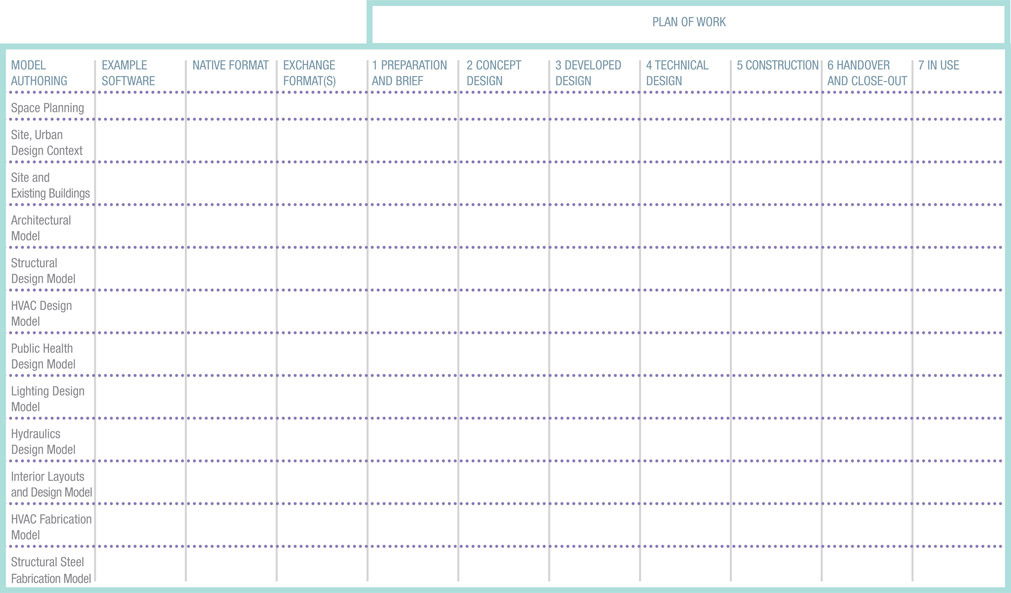
Information delivery plans form a key part of the Post-Contract BEP. The Task Information Delivery Plans (TIDPs) are submitted by information managers from all sub-disciplines into an overall Master Information Delivery Plan (MIDP). In basic terms, the role of information manager could be assumed by each firm’s document controller. The key difference is that the responsibility for issuing correctly formatted data extends beyond hard-copy output to include a far wider variety of updateable files, including models.
PAS-1192:2 (7.4.3 to 7.4.5) explains the uses of TIDPs as follows:
- Milestones within each TIDP shall be aligned with the design and construction programmes to produce the MIDP
- For each deliverable, TIDPs shall be used to indicate the team member responsible or to note that responsibility has yet to be allocated
- TIDPs shall be used to show how responsibility for the preparation of project documents transfers from one team member to another
- TIDPs shall be used to take account of the required sequence of model preparation for any work packages used in the project.
The table below shows an example of the TIDP. The Project Architect would develop this schedule in conjunction with any other required deliverables. It is important to remember that as part of the ‘Pull’ strategy, the designer lead and contractor lead are expected to coordinate the lower-tier TIDPs into the Master Information Delivery Plan:
Information Manager
The CIC BIM Protocol outlines the Information Management role, appointed initially by the Employer. This person is therefore a client representative.
The job involves managing the following processes and procedures for information exchange on projects:
- Initiating and implementing the Project Information Plan and Asset Information Plan, including:
- ○ Common information structure across all project roles, e.g. non-proprietary software platforms (all levels of supply chain) appropriate to meet Employer requirements and Project Team resources
- ○ Responsibility for provision of information at each Project Stage
- ○ Establishing Level of information required for outputs at specific project stages by updating the Model Production and Delivery Table
- ○ The process for incorporating ‘as constructed’, testing, validation and commissioning information.
- Agreeing formats for Project Outputs, such as data drops
- Assisting Project Team Members in assembling information for Project Outputs
- This role does not involve clash detection and model coordination, since these are BIM Coordinator activities.
BIM managers will be expected to work closely with the client’s Information Manager in order to deliver data in accordance with the agreed Employer’s Information Requirements.

Plain Language Questions – Model answers
As part of the review process conducted at the end of each work stage, the client will require information from the design and construction team that will assist in project evaluation.
For each of these reviews – known as gateways – and as a means of ensuring value for money for stakeholders, plain language questions (PLQs) are used to elicit the supplier’s response to the client’s key criteria for authorising the project to proceed to the next stage.
PAS-1192-2 describes information exchanges as the required response to these PLQs. The information exchanges (also known as ‘data drops’) supply comprehensive and consistently structured data that has been collated and exported from BIM at these key project intervals.
The table on the next page is adapted from the PLQs used by the Ministry of Justice on ‘early adopter’ BIM projects. The second column describes data drop components formulated by the design team from the federated Project Information Model.
In describing these data drop components above, you will notice that the words ‘linked’ and ‘exported’ are used repeatedly. In each case, we are seeking through BIM to ensure that the data is being re-used, rather than incurring the expense of it being re-created.
Distinctions between Roles and Official appointments
While PAS-1192 and other official documents mention a number of key BIM roles, none of these is necessarily a formal full-time appointment. The scale and complexity of the project and its information requirements will determine whether the latter is justified.
For the sake of clarity, the BIM Manager is responsible for developing appropriate firm-wide BIM standards and is also the ‘catalyst’ who ensures that they are adopted and implemented across the entire organisation. The next chapter will show how the BIM Manager’s role can be developed by encouraging and training an existing staff member to become the initial BIM champion. Nevertheless, there is the caveat that extending a role in this way indefinitely without an official appointment or adequate remuneration may be counter-productive, especially if it leads to eventual disillusionment and the BIM champion’s decision to take their acquired BIM skills elsewhere.
The role of Information Manager is project-focused and akin to that of a document controller. The distinction lies in the wide variety of data that must be vetted by the Information Manager for issue at each project milestone. This extends far beyond static hard-copy documentation to include the full range of model types that must be collected, combined and exported with other data for information, visualisation and analysis purposes.
The BIM coordinator is a project role, normally assigned to a design or construction professional on the team. This person is instrumental in reducing the likelihood of inter-disciplinary design and construction conflicts by working under the guidance of the technical coordinator in order to resolve coordination issues in the 3D model environment (as described in Chapter 5).
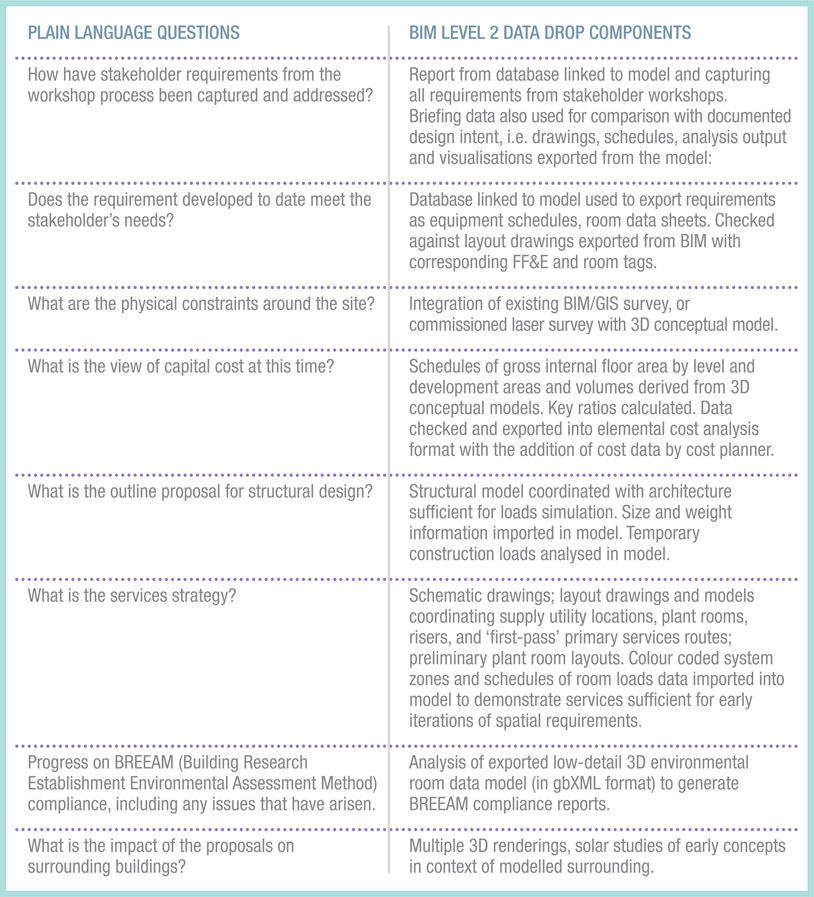
Conclusion
The Government Construction Strategy, and the guidance of PAS-1192-2 in particular, has established BIM Level 2 as the benchmark framework for implementing a regime of exchanging information via data linked to elements comprising the issued 3D model. BIM Level 2 involves the design lead and/or contractor lead marshalling their respective supply chains to deliver critical project data which represents the key inputs of all specialists and sub-contractors in conjunction with their combined models.
In the absence of in-house expertise, the client should rely upon an experienced external technical adviser to formulate the Employer’s Information Requirements for this type of project delivery via BIM.
As a rule, it is important to conduct a careful assessment of the Employer’s Information Requirements, requesting clarification and amendment where necessary. In response to these requirements, the design and construction suppl zier are expected to develop coherent pre- and post-contract iterations of the BIM Project Execution Plan.
The Information Manager is appointed initially by the Employer to ensure that timely information is provided in the correct format and to the correct level of detail, in accordance with:
- The Model Production and Delivery Table
- Task/Master Information Delivery Plans
- BIM Protocol.
